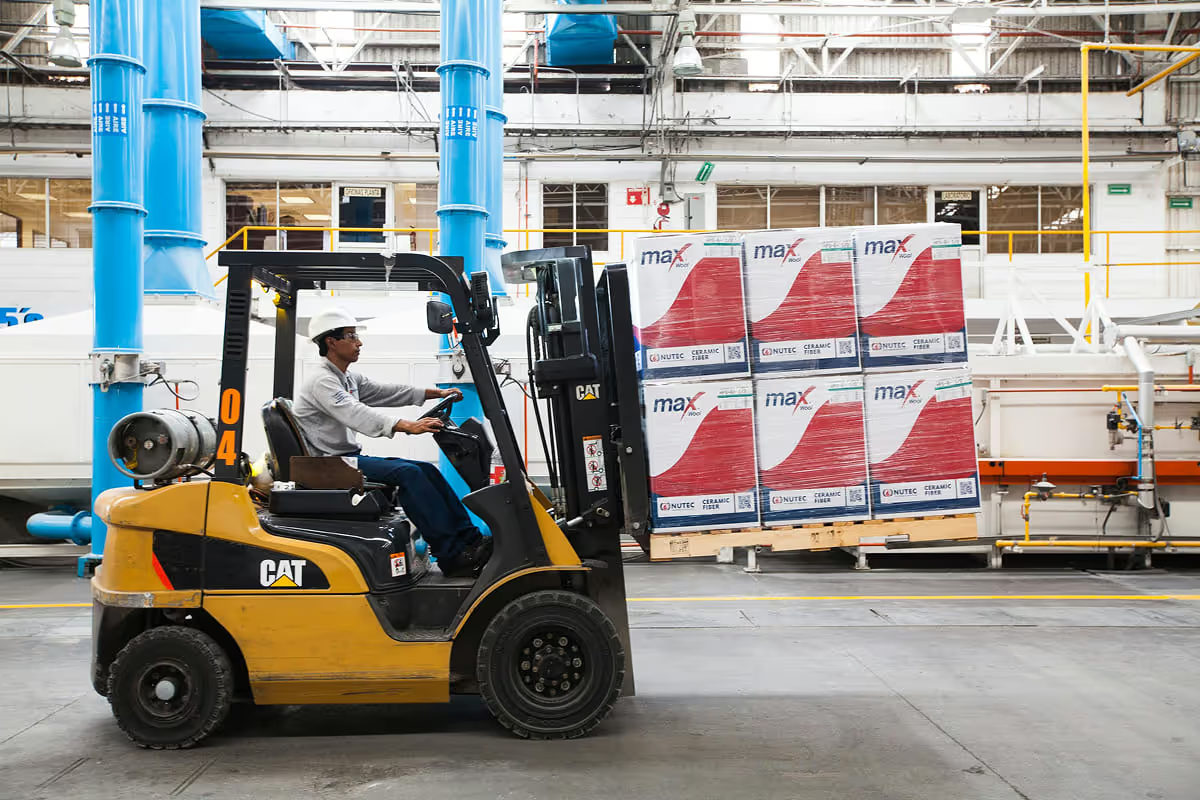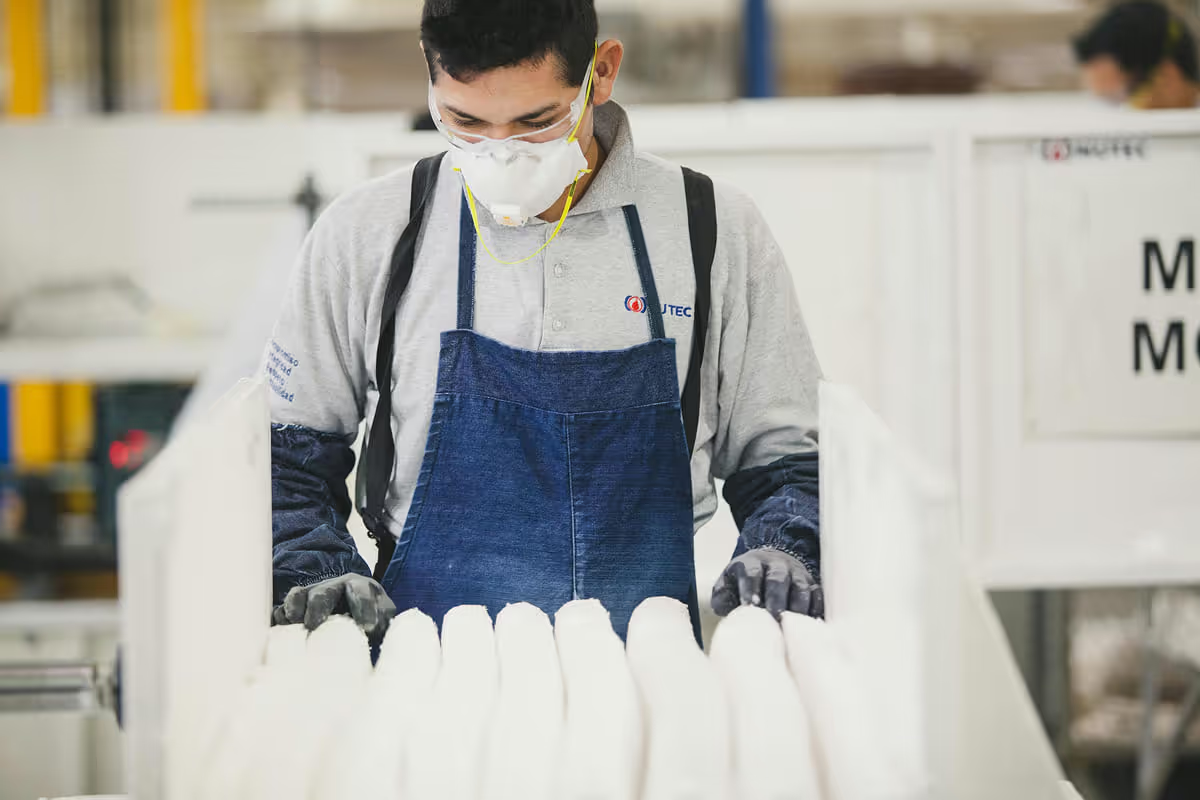
English (Global)
Article
Ceramic Fiber Insulation for High Temperatures
Ceramic Fiber Insulation: Advanced thermal solution for the industrial sector, ideal for high temperature environments. Optimize your insulation today.
By Christian Tavira
Application Engineering & Technical Support Manager - NUTEC
What is a ceramic fiber?
Ceramic fiber is essential in various industries involving high-temperature operations. It offers superior thermal resistance for protecting structures, equipment, and machinery, from steel and glass production to airplane and space vehicle manufacture.
In this article, we will detail the characteristics of the ceramic insulating fiber and some of its main attributes and use classification dependent on chemical composition and shape.
What is ceramic fiber used for?
Ceramic fiber is a lightweight and flexible insulator with low thermal conductivity and minimal heat storage, features that make it ideal for various industries, including petrochemical, ceramics, automotive, construction, and energy, among others. It is widely used in furnace linings, boiler insulation, gaskets, and passive fire protection systems.
Is ceramic fiber heat resistant?
Ceramic fiber stands out for its exceptional heat resistance, capable of withstanding high temperatures up to 1425 °C (2600 °F). This superior thermal performance makes it the ideal solution for industrial applications in high-demand environments such as furnaces, boilers, and combustion chambers.
What is high temperature ceramic fiber?
Ceramic fibers are synthetic materials comprising small filaments made from high-purity aluminosilicate minerals.
Thanks to their particular properties and composition, ceramic fiber products contribute to preventing and reducing heat losses, in addition to protecting, providing insulation, and optimizing the energy performance of equipment, structures, and process machinery.
5 main characteristics of ceramic fiber
Ceramic fiber insulation is ideal for high temperature management due to its characteristics, such as:
- Low density. Due to its composition, ceramic fiber has a lower density than other materials, giving it an advantage in its lightness and flexibility. This makes it easy to install and transport.
- Low heat storage. It cools down more quickly, making it ideal when immediate access and handling are required. It has proven excellent for both intermittent and continuous operation applications.
- Low heat loss. It can reduce heat transfer and provide good thermal protection.
- Resistance to thermal shock. It withstands sudden changes in temperature without suffering damage.
- Low thermal conductivity. This reduces heat transfer and provides efficient heat shielding.
High-temperature ceramic fiber is an advanced material designed to withstand temperatures up to 1425°C (2600°F). Its lightweight structure and inherent flexibility deliver highly efficient insulation for furnaces, boilers, and industrial facilities, acting as an essential barrier against heat and fire.
Due to its properties and composition, ceramic fiber effectively prevents and reduces heat loss. It also enhances thermal protection and efficiency by optimizing the energy performance of equipment, structures, and industrial machinery.
High temperature ceramic fiber manufacturers
Ceramic fiber manufacturers, like NUTEC, design cutting-edge thermal solutions for industries that demand reliable, high-performance insulation. Thanks to its thermal, chemical, and mechanical resistance, ceramic fiber is well-suited for demanding, custom-engineered projects, backed by expert technical support and full compliance with the most stringent international standards.
With over 50 years of experience, at NUTEC we are manufacturers of high-temperature ceramic fiber. Is committed to delivering high-performance thermal solutions tailored to the most demanding industrial environments, featuring certified quality, specialized technical support, and a constant focus on energy efficiency and operational safety.
The experts at NUTEC are ready to assist you with solutions to your needs. Contact us.
Why Choose Ceramic Fiber for Your Plant?
Ceramic fiber is one of the most effective solutions for thermal insulation in demanding industrial environments. Its combination of thermal, physical, and chemical properties makes it ideal for optimizing processes, reducing energy costs, and enhancing operational safety.
Choosing ceramic fiber not only improves your plant’s thermal efficiency but also helps reduce maintenance times, protects critical equipment, and complies with safety standards in high-temperature applications.
When working with ceramic fiber manufacturers, ensure they offer international certifications, demonstrate proven experience in industrial applications, and have the ability to provide tailored solutions that meet the specific needs of your process.
Comparison of ceramic fiber with other insulators
Unlike heavier or more rigid insulating materials, ceramic fiber is exceptionally lightweight, flexible, and easy to install, even in confined or complex areas. Its superior thermal performance and durability make it the preferred choice for the most critical and demanding insulation applications.
We invite you to read our article on the advantages and benefits of ceramic fiber compared to other insulation materials. Thermal Insulation types – Pros and Cons You Need to Know – NUTEC
Classification of high temperature insulation fibers
High Temperature Insulating Wools are used in applications that can exceed 1112°F (600°C). Depending on your application, they come in various product formulations and chemistries/temperatures. Three main categories are easily available on the market.
Chemical composition/Temperature classification
- Refractory Ceramic Fiber. One of our product lines is MaxWool 2300, which is composed of a mixture of alumina and silica. This material can be used for temperatures up to 2300°F (1260°C). Another product line is our MaxWool 2600, composed of a mixture of alumina, silica, and zirconia. This material can be used for temperatures up to 2600°F (1425°C).
- Low Biopersistent fiber. Our LBP product line is SuperMag 2200. It comprises low biopersistence fibers (also known as biosoluble fibers). They contain a chemical composition of calcium, silica, and magnesium. This product is used at temperatures up to 2200°F (1200°C).
- Polycrystalline fiber wool. Here we find MaxWool 3000. This product is made from fibers that contain a polycrystalline mullite chemical composition, which allows for high tensile strength, durability, and low shrinkage at high temperatures.

Presentation/Product classification
High temperature fibers appear like cotton wool when manufactured. Ceramic fiber insulation can be formed into different products depending on the needs and type of application. At NUTEC, we are manufacturers of ceramic fiber in USA. The most common forms are:
- Ceramic Fiber Blankets. Fibers are converted into a blanket through a weaving process. They're used to reduce energy consumption, improve the performance of thermal processes, and increase fire safety in different industrial applications.
- Ceramic Fiber Bulk. Fibers collected after the fiberization process and whose main application is to be used as a raw material for other manufacturing processes.
- Ceramic Fiber Boards. Composed of fibers and a variety of organic and/or inorganic binder fillers that acquire a rigid quality through the vacuum-forming process. They are commonly used as sheeting/cladding and thermal barriers in high temperature equipment.
- Ceramic Fiber Paper. This is a light refractory material. It is strong and can be cut with a utility knife, scissors, or a standard steel razor. Its flexibility allows it to be wrapped or rolled to conform to whichever shapes are required.
- Ceramic Fiber Modules. Fiber blocks are designed to protect industrial furnaces and provide a high quality insulation system for different processes. Each module is continuously compressed and folded according to a density that contributes to providing a longer useful life to industrial furnaces.

Applications of high temperature ceramic fiber insulation by industry
Due to its characteristics, ceramic fiber has various industrial applications. For example:
- Ceramics and glass industry. For insulation in furnace car seals and lining in doors and walls.
- Automotive industry. For electric vehicles and conventional trains, from exhaust heat shields and airbag inflators to lithium battery separators.
- Construction Industry. For both ventilation ducts or grilles (commercial premises, hotels, restaurants, and casinos), chimneys, and prefabricated duct systems.
- Oil & gas industry. Protects structures and equipment, such as pyrolysis ovens, heaters, walls, roofs, and crude oil heaters.
- Power generation industry. For boilers, turbines, and pipe insulation, among others.
To sum up
Ceramic fiber insulation has high thermal resistance. Their low conductivity and low heat storage improve process efficiency and promote energy savings.
Remember that the ceramic fiber you need will be determined by the temperature level you use and the equipment you want to protect from heat.
Did you find this content helpful? At NUTEC, we are manufacturers of ceramic fiber in USA. You can find more about our ceramic fiber insulation products here!
Want to know more?
At NUTEC, we are committed to providing you with valuable content that helps you make informed decisions for your business. Thank you for taking the time to read this entry and we hope it provided you with insights that you can apply to your operations.
If you have any questions or would like to learn more about our products, please don’t hesitate to contact us.
To get in touch, simply fill out the form, and one of our experts will get back to you as soon as possible.
© NUTEC Incorporated 2025



